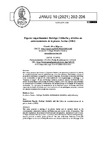Mostrar o rexistro simple do ítem
Figuras impertinentes: Rodrigo Calderón y el Libro de entretenimiento de la pícara Justina (1604)
| dc.contributor.author | Mesa Higuera, Claudia | |
| dc.date.accessioned | 2021-04-16T10:18:38Z | |
| dc.date.available | 2021-04-16T10:18:38Z | |
| dc.date.issued | 2021-02-11 | |
| dc.identifier.citation | Mesa Higuera, C. (2021). Figuras impertinentes: Rodrigo Calderón y el “Libro de entretenimiento de la pícara Justina” (1604). Janus: estudios sobre el Siglo de Oro, 10, 202-236. https://www.janusdigital.es/articulo.htm?id=163 | es_ES |
| dc.identifier.issn | 2254-7290 | |
| dc.identifier.uri | http://hdl.handle.net/2183/27766 | |
| dc.description.abstract | [Resumen] Este ensayo propone una lectura de La pícara Justina y sus paratextos, a partir de la relación de complementariedad entre el self-fashioning y las artes plásticas. Este análisis subraya el potencial de emblemas y jeroglíficos, escudos y empresas, de moldear la identidad individual y así contrarrestar la fijación del orden establecido con la genealogía, el abolengo, y la “limpieza de sangre”. El caso de Rodrigo Calderón, poderoso ministro de Felipe III, cuyo escudo de armas figura en la portada de la editio princeps, sirve como ejemplo para investigar la conexión entre la heráldica y el fenómeno del self-fashioning, en la España de la temprana modernidad. Por una parte, la manipulación de la identidad a partir de formas simbólicas representa un desafío al sistema; por otra, la adopción de sus paradigmas perpetúa y sustenta los idearios culturales sobre los que está construido. | es_ES |
| dc.description.abstract | [Abstract] This essay proposes a reading of La pícara Justina and its paratexts based on the complementary relationship between self-fashioning and artistic modes of expression. This analysis emphasizes the potential of emblems and hieroglyphics, imprese and coats of arms, to shape individual identity in order to counteract the establishment’s fixation with genealogy, ancestry, and the so-called “purity of blood”. The case of Rodrigo Calderón, a powerful political figure at the court of Philip III whose coat of arms is featured on the title page of the first edition, offers an example to investigate the connection between heraldry and the process of self-fashioning in early modern Spain. On the one hand, the exercise of shaping one’s public persona through symbolic forms of representation constitutes a challenge to the social order; on the other hand, the adoption of its own paradigms, contributes to perpetuate discriminatory cultural practices and prevailing ideologies. | es_ES |
| dc.language.iso | spa | es_ES |
| dc.publisher | Universidade da Coruña | es_ES |
| dc.relation.uri | https://doi.org/10.51472/JESO20211013 | es_ES |
| dc.rights | Atribución-NoComercial-SinDerivadas 4.0 Internacional | es_ES |
| dc.rights.uri | http://creativecommons.org/licenses/by-nc-nd/4.0/ | * |
| dc.subject | La pícara Justina | es_ES |
| dc.subject | Rodrigo Calderón | es_ES |
| dc.subject | Emblemática | es_ES |
| dc.subject | Heráldica | es_ES |
| dc.subject | Emblem studies | es_ES |
| dc.subject | Heraldry | es_ES |
| dc.subject | Self-fashioning | es_ES |
| dc.title | Figuras impertinentes: Rodrigo Calderón y el Libro de entretenimiento de la pícara Justina (1604) | es_ES |
| dc.title.alternative | Impertinent Figures: Rodrigo Calderón and the Libro de entretenimiento de la pícara Justina (1604) | es_ES |
| dc.type | info:eu-repo/semantics/article | es_ES |
| dc.rights.access | info:eu-repo/semantics/openAccess | es_ES |
| UDC.journalTitle | Janus: estudios sobre el Siglo de Oro | es_ES |
| UDC.volume | 10 | es_ES |
| UDC.startPage | 202 | es_ES |
| UDC.endPage | 236 | es_ES |
| dc.identifier.doi | 10.51472/JESO20211013 |






